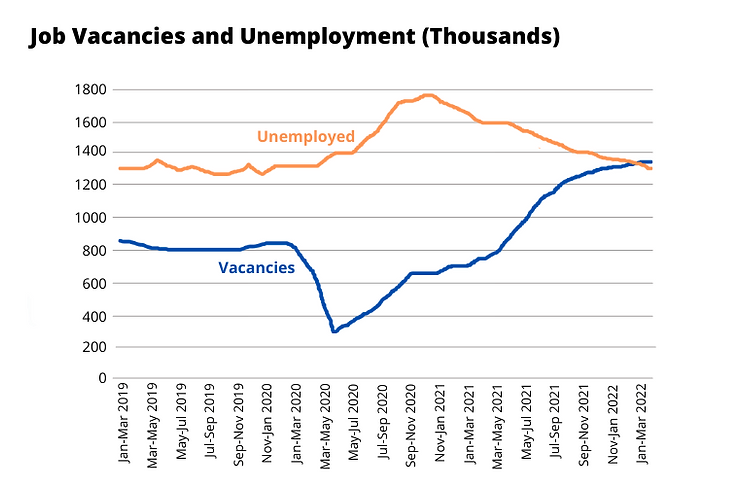For the first time in the history of the United Kingdom, it is facing its very first labour shortage crisis at the moment. The penultimate release (17th May 2022) on UK Employment by the Office for National Statistics (ONS), showed that for the first time in the history of the UK, there are more job vacancies than unemployed people.
The latest figures released by the ONS on the 16th of August, the time period from April to June 2022 show a further decrease in the employment rate compared to the first three months of the year.

The 2020 Coronavirus pandemic seems to be at the root of this imbalance between the employment demand and supply. Ever since economic activities were allowed to continue at the end of Coronavirus lockdowns imposed by the government, the UK job market witnessed a surge in vacancies for up to 1.3 million.
From an economic point of view, a record surge in vacancies is a textbook solution for improving unemployment rates, but the UK job market does not seem to be complying with this. Employers are witnessing their staff failing to turn up for their shifts and new job candidates skipping interviews on a regular basis. Staff recruitment companies state that now it takes several months to fill a vacancy which would have been filled within a couple of days before the pandemic struck.
However, statistics show that this unfulfilled demand for labour is not because of the skyrocketed vacancy numbers, but because the labour force is shrinking. The ONS report for Employment in the UK: August 2022 records that economic inactivity is 1.2% higher than it was before the Coronavirus pandemic.
Since 2019, more than 450,000 people have simply left the workforce due to various reasons and are economically inactive at the moment. Had the pre-pandemic economic trends continued, the UK was expected to have 1 million more people within the age group of 16-64 years, employed in the labour force. However, this is only the tip of the iceberg. Researches show that this shortage of people only makes up a quarter of the workforce decline, and the rest is caused by an army of existing workers withdrawing from the workforce altogether.
Looking deeper into the workforce withdrawals sheds some light on what their reasons are. Long-term sick people following the Coronavirus outbreak, have been on the climb since the beginning of 2019, and the number of people who made the outbreak a reason to retire has also increased exponentially. Among the reasons for workforce withdrawal, the number of temporary sick people and the number of students have also been on the rise.
The issue is not how or when the labour shortage happened in the UK, but finding ways to deal with it. Even though the government has set up some protocols to tackle the issue, business owners in almost every industry are going through tough times having to increase staff wages and product prices alike, with the hospitality industry facing the biggest blow.
What Should Be Done?
Under rules set by the government, job seekers on unemployment benefits will have to search for jobs outside their preferred occupation or sector from the fourth week of their benefit claim, instead of after three months. If they turn down a job offer from this point, they will be penalised by having their benefits cut (Financial Times, 31st January 2022).
Apart from these policies, there are other areas that can be attended to solve the labour shortage issue.
Implementing geographically targeted policies that can tackle the situation is welcome in such an environment. For example, investing in skills and infrastructure where there is a need for highly compensated jobs is always a wise choice when facing a labour shortage. Offering compelling employment packages that include flexible working hours, remote working options, adequate transportation/housing facilities and training opportunities in areas where there is a need for more workers can also prove to be successful.
Referring to the fact that the majority of those who withdrew from the workforce are people over 50 years of age, encouraging them to seek employment by offering attractive and flexible retirement plans can prove to be effective. Employers themselves can further turn things around by offering part-time job opportunities as well.
Apart from all these strategies to attract more workers, the labour shortage issue can be alleviated to a certain extent without the involvement of human resources. The shortage of workers is a powerful motivation for automation in industries, which can also create more job opportunities for the future while taking care of the current lack of labour.
Even though human involvement is essential to run any business, innovative technologies have overturned the market, coming up with more and more elaborate solutions for the labour shortage. For example, the implementation of POS systems in retail shops and restaurants has provided a somewhat satisfactory answer to the issue.
Although automation screams robotics, rather than going for such expensive methods at the initial stage of the issue, it is always wise for businesses to tackle the labour shortage via simple solutions such as POS systems and other products that can make business processes more efficient, with a minimum workforce.
